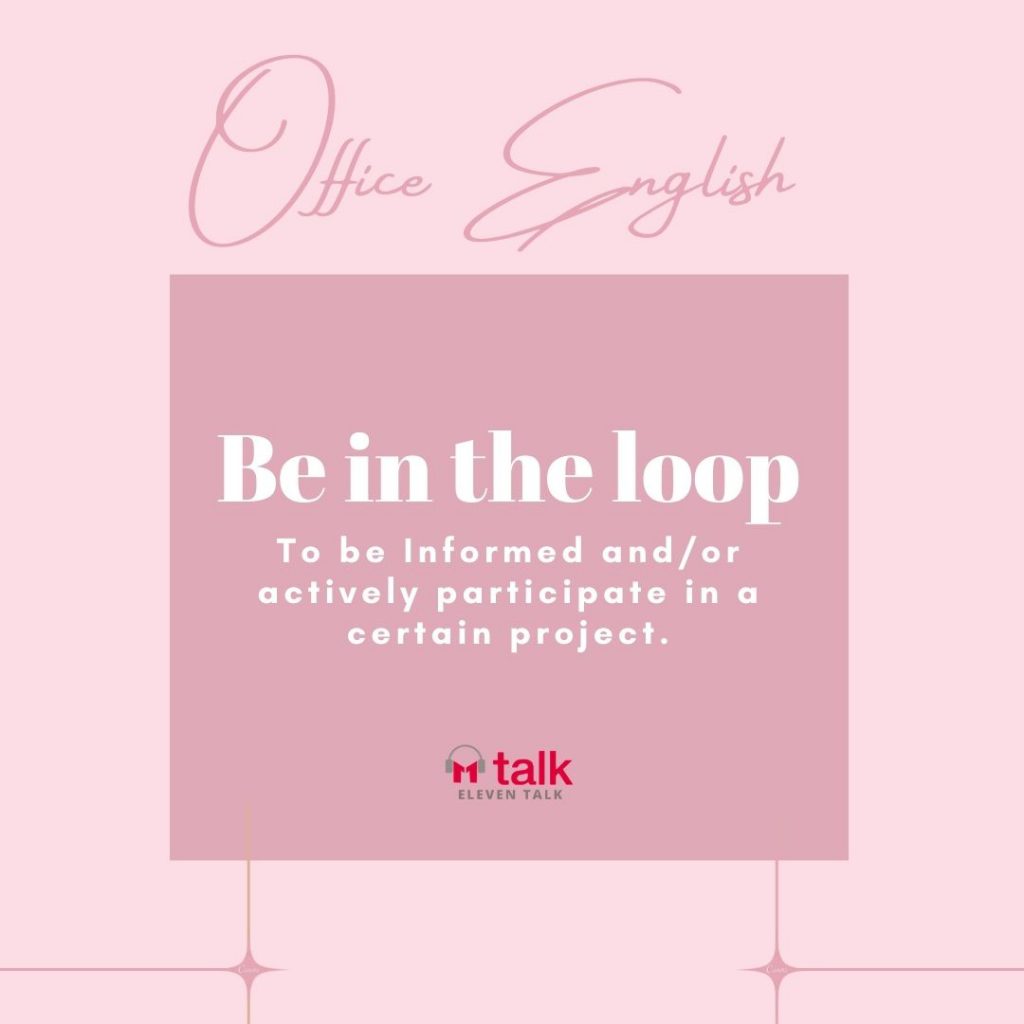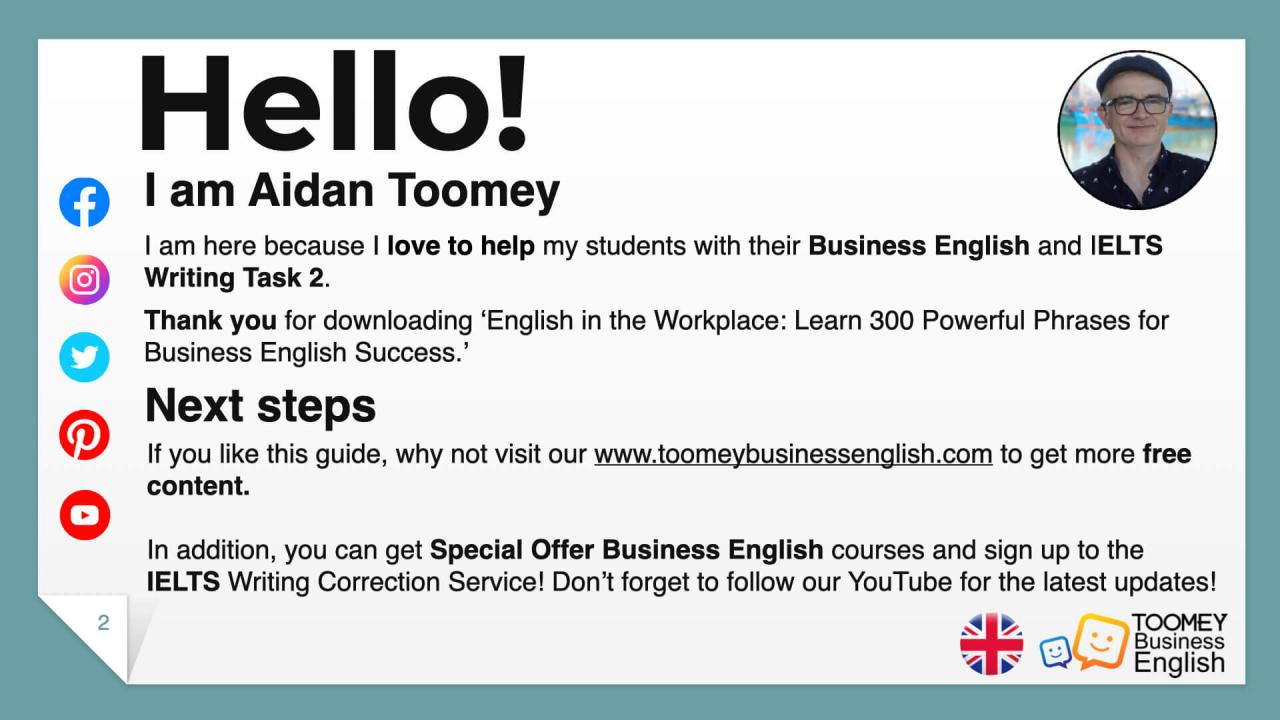How business English speakers link phrases is crucial for effective communication. Mastering the art of connecting ideas smoothly and naturally is key to delivering persuasive presentations, negotiating favorable deals, and crafting professional emails. This guide delves into the nuances of linking phrases, providing practical examples and strategies to elevate your business English communication skills. We’ll explore a wide range of phrases, analyzing their context and application across various business settings.
From understanding the subtle differences between seemingly similar phrases to mastering advanced techniques like transitional paragraphs and visual representations, this comprehensive guide equips you with the tools to communicate with clarity, precision, and impact. We’ll show you how to structure your sentences and arguments logically, enhancing your persuasiveness and leaving a lasting impression on your audience.
Common Linking Phrases in Business English
Effective communication in business relies heavily on the skillful use of linking phrases. These phrases act as bridges, smoothly connecting ideas and ensuring a logical flow in both written and spoken communication. Mastering these phrases enhances clarity, strengthens arguments, and ultimately improves the overall impact of your message. This section details common linking phrases, their nuanced applications, and comparisons of similar phrases to avoid confusion.
List of Common Linking Phrases
The following table categorizes fifteen common linking phrases used in business English, illustrating their diverse applications in different contexts. Understanding the subtle differences between these phrases is crucial for precise communication.
| Phrase | Context/Nuance | Example | Category |
|---|---|---|---|
| Furthermore | Adds information; builds on a previous point. | “Furthermore, our market research indicates a strong potential for growth.” | Addition |
| Moreover | Similar to “furthermore,” emphasizes additional information. | “Moreover, the proposed strategy aligns with our long-term objectives.” | Addition |
| In addition | Introduces supplementary information. | “In addition to cost savings, this new system improves efficiency.” | Addition |
| However | Indicates a contrast or exception. | “However, there are some challenges we need to address.” | Contrast |
| Nevertheless | Similar to “however,” suggests a contrast despite a previous point. | “Nevertheless, we remain confident in the project’s success.” | Contrast |
| On the other hand | Presents an alternative perspective. | “On the other hand, we could explore alternative solutions.” | Contrast |
| Therefore | Indicates a logical consequence or conclusion. | “Therefore, we recommend implementing the proposed changes.” | Conclusion |
| Consequently | Similar to “therefore,” shows a result or effect. | “Consequently, the project was delayed by several weeks.” | Conclusion |
| As a result | Highlights the outcome of a previous action or event. | “As a result, we saw a significant increase in sales.” | Conclusion |
| For example | Introduces an illustrative example. | “For example, we could invest in new marketing campaigns.” | Example |
| For instance | Similar to “for example,” provides a specific instance. | “For instance, the recent economic downturn impacted our profits.” | Example |
| In other words | Clarifies or rephrases a previous statement. | “In other words, we need to improve our customer service.” | Clarification |
| To summarize | Signals a summary of previously discussed points. | “To summarize, the key findings indicate a positive outlook.” | Summary |
| In conclusion | Indicates the final point or summary of a presentation or discussion. | “In conclusion, we believe this proposal offers significant benefits.” | Summary/Conclusion |
| Specifically | Highlights a particular detail or aspect. | “Specifically, we need to focus on improving our online presence.” | Emphasis |
Comparison of Similar Linking Phrases
Several linking phrases share similar functions but possess subtle differences in meaning and application. Careful selection enhances the precision and impact of your communication.
“Furthermore” vs. “Moreover”
While both “furthermore” and “moreover” add information, “furthermore” suggests a sequential addition, building upon the previous point in a linear fashion. “Moreover” implies a more emphatic addition, often highlighting a stronger supporting point. For example, “The product is innovative. Furthermore, it’s cost-effective.” presents a sequential argument, while “The product is innovative. Moreover, it addresses a critical market need.” emphasizes the significance of the additional point.
“However” vs. “Nevertheless”
Both “however” and “nevertheless” introduce contrasting information. “However” is more common and generally less formal. “Nevertheless” suggests a stronger contrast, implying that the contrasting point is significant despite the preceding information. For instance, “The market is competitive. However, we have a strong brand reputation.” uses a general contrast, whereas “The market is competitive. Nevertheless, we plan to increase our market share through aggressive marketing.” emphasizes the determination despite the challenge.
“Therefore” vs. “Consequently”
Both “therefore” and “consequently” indicate a logical consequence. “Therefore” suggests a direct and immediate consequence. “Consequently” implies a more indirect or delayed consequence, often involving a chain of events. For example, “The sales figures are low; therefore, we need to adjust our strategy.” shows a direct consequence, while “The supply chain was disrupted; consequently, production was delayed.” indicates a more indirect consequence.
Linking Phrases for Different Business Contexts: How Business English Speakers Link Phrases
Effective communication in business relies heavily on the skillful use of linking phrases. These phrases act as bridges, smoothly connecting ideas and ensuring a logical flow of conversation or writing. Mastering their application across various business settings is crucial for conveying professionalism and achieving clear communication. This section will illustrate how different linking phrases enhance coherence and professionalism in meetings, presentations, negotiations, and email correspondence.
Linking Phrases in Business Meetings
Utilizing appropriate linking phrases in meetings ensures a smooth and efficient exchange of ideas. They facilitate transitions between discussion points and help maintain focus. For instance, phrases like “building on that point,” or “to elaborate further,” create a seamless connection between different speakers’ contributions. Conversely, abrupt transitions can disrupt the flow and create confusion.
Example Dialogue:
Speaker A: “The marketing campaign’s initial results are promising, with a 15% increase in website traffic.”
Speaker B: “Building on that point, let’s discuss how we can leverage this momentum to increase sales conversions.”
Speaker C: “To add to that, we should analyze the demographics of the increased traffic to better target future campaigns.”
Linking Phrases in Business Presentations
In presentations, linking phrases are essential for guiding the audience through your arguments and maintaining their engagement. They provide a clear structure and help the audience follow the progression of your ideas. The use of transitional phrases such as “in addition,” “moreover,” or “consequently” adds clarity and professionalism.
Example Dialogue:
Presenter: “Our new product offers several key advantages. First, it’s significantly more efficient. Moreover, it’s more cost-effective. Consequently, we project a substantial return on investment.”
Linking Phrases in Business Negotiations
Negotiations demand careful phrasing to maintain a professional and collaborative tone while achieving your objectives. Linking phrases allow for graceful transitions between offers, counter-offers, and compromises. Phrases such as “however,” “on the other hand,” and “in order to” can be skillfully used to navigate disagreements constructively.
Example Dialogue:
Negotiator A: “We’re prepared to offer a 10% discount.”
Negotiator B: “We appreciate the offer; however, we were hoping for a 15% discount to make this deal viable for us.”
Negotiator A: “In order to reach an agreement, we could compromise on a 12% discount.”
Linking Phrases in Business Email Correspondence
Email communication necessitates clear and concise language. Linking phrases maintain the flow of information and ensure your message is easily understood. Phrases like “furthermore,” “in conclusion,” and “as a result” enhance readability and professionalism.
Example Dialogue:
Email Body: “Thank you for your prompt response. Furthermore, I’ve attached the revised proposal as requested. As a result, we can proceed with the next steps of the project.”
Summary of Effective Linking Phrases
| Business Context | Effective Linking Phrases |
|---|---|
| Meetings | Building on that point, to elaborate further, to add to that, in other words, however, consequently |
| Presentations | First, second, third, moreover, in addition, consequently, therefore, in conclusion |
| Negotiations | However, on the other hand, in order to, nevertheless, alternatively, therefore, to clarify |
| Email Correspondence | Furthermore, in addition, as a result, consequently, therefore, in conclusion, finally |
Analyzing the Flow and Structure with Linking Phrases

Effective linking phrases are the connective tissue of clear and persuasive business communication. They seamlessly guide the reader through your ideas, ensuring a logical progression and enhancing the overall impact of your message. Without them, your writing can feel disjointed and difficult to follow, potentially losing your audience’s attention and undermining your arguments.
The strategic use of linking phrases significantly improves the clarity and flow of business communication. They create a smooth transition between sentences and paragraphs, preventing abrupt shifts in thought and maintaining reader engagement. This is particularly crucial in business writing, where precision and conciseness are highly valued. Consider the impact of poorly structured sentences and how carefully chosen linking words can transform them.
Improved Clarity and Flow Through Linking Phrases
Poorly structured sentences often lack coherence, making it difficult for the reader to grasp the intended meaning. For example, consider this poorly structured sentence: “The marketing campaign launched last month. Sales increased significantly.” The connection between the campaign and the sales increase is implied but not explicitly stated. Using a linking phrase clarifies the relationship: “The marketing campaign launched last month, resulting in a significant increase in sales.” This revised sentence demonstrates a clear cause-and-effect relationship, making the information much easier to understand. Another example: “The new software is user-friendly. It increases productivity.” A better version: “The new software is user-friendly, and consequently, it increases productivity.” The addition of “and consequently” strengthens the connection and improves the logical flow.
Enhanced Persuasiveness Through Strategic Linking
Strategic use of linking phrases can significantly enhance the persuasiveness of business arguments. By carefully selecting linking words that highlight cause and effect, comparison, or contrast, you can build a compelling narrative that leads the reader to your desired conclusion. For instance, consider the difference between: “Our product is innovative. It’s also cost-effective.” and “Our product is not only innovative but also cost-effective, making it the ideal solution for your needs.” The second version, using “not only…but also,” creates a more persuasive argument by highlighting the multiple benefits of the product. Similarly, using phrases like “therefore,” “thus,” or “as a result” to demonstrate logical conclusions strengthens your argument and increases the reader’s acceptance of your viewpoint.
Examples of Sentence Structures and Linking Phrases
The following examples illustrate how different sentence structures can be linked using various phrases to create a logical progression of ideas:
- Adding information: “The project is on schedule. Furthermore, we are ahead of budget.” (Furthermore adds supporting information)
- Showing contrast: “The initial results were disappointing. However, subsequent analysis revealed positive trends.” (However introduces a contrasting point)
- Indicating cause and effect: “Sales have declined. Therefore, we need to reassess our marketing strategy.” (Therefore shows a direct consequence)
- Giving examples: “Several factors contributed to the success. For instance, the strong marketing campaign and the positive customer reviews played a crucial role.” (For instance introduces specific examples)
- Summarizing information: “We’ve analyzed the data, conducted market research, and consulted with experts. In conclusion, we recommend proceeding with the acquisition.” (In conclusion summarizes the preceding points)
Advanced Linking Techniques for Business English

Mastering basic linking phrases is crucial for clear communication, but truly effective business English requires a more sophisticated approach. This involves strategically employing transitional paragraphs and leveraging linking phrases to create a seamless flow of ideas, particularly across complex arguments and extended pieces of writing or presentations. This section explores advanced techniques to elevate your business communication.
Transitional paragraphs act as bridges, smoothly connecting distinct sections of a document or presentation. They summarize the preceding section, highlighting key takeaways, and then introduce the upcoming section, establishing a clear link between the two. This avoids abrupt shifts in topic and ensures the reader or listener maintains a coherent understanding of the overall argument. Effective transitional paragraphs often employ a variety of linking phrases to achieve this smooth transition.
Transitional Paragraphs and Inter-Paragraph Linking
Consider a report analyzing market trends. One section might discuss declining sales in a specific region. The following section could analyze potential causes. A transitional paragraph would effectively link these two, for example: “The preceding section detailed the significant downturn in sales within the North American market. This decline, however, is not an isolated incident, and a deeper investigation into underlying causes is warranted. Consequently, the following section will explore potential factors contributing to this downturn, focusing specifically on…” This paragraph summarizes the previous point (“significant downturn”), introduces the next (“deeper investigation”), and explicitly states the connection (“Consequently”). Other linking phrases that could be used include “Therefore,” “Subsequently,” “In light of this,” and “Building upon this analysis.”
Summarizing Key Points and Creating a Clear Conclusion, How business english speakers link phrases
Effective use of linking phrases is vital for concisely summarizing key findings and delivering a powerful conclusion in business presentations and reports. Instead of simply restating points, skilled communicators weave them together using sophisticated linking words and phrases to highlight the overall narrative. This strengthens the impact of the conclusion and leaves a lasting impression.
Presentation Script Demonstrating Sophisticated Linking
The following is a short presentation script showcasing advanced linking techniques. The script addresses a hypothetical scenario involving a company considering a new product launch.
“Good morning, everyone. Today, we’ll be discussing the proposed launch of Project Nova. Firstly, we’ll examine the market analysis, highlighting the significant unmet need this product addresses. Furthermore, we’ll delve into the projected financial returns, demonstrating a strong ROI within the first year. Having established the market viability and financial projections, we’ll then transition to the operational aspects, outlining the production timeline and key milestones. In conclusion, based on the robust market analysis, promising financial forecasts, and a feasible operational plan, we strongly recommend proceeding with the launch of Project Nova. This decision, we believe, represents a significant opportunity for growth and will solidify our position in the market.”
Visual Representation of Linking Phrase Usage

A compelling visual representation can significantly enhance audience understanding of how linking phrases structure and clarify business presentations. Imagine a visual that moves beyond simple bullet points and instead portrays the dynamic flow of ideas, emphasizing the crucial role of transitional phrases. This visual approach makes the often-abstract concept of effective communication immediately tangible and memorable.
This visual would take the form of a network diagram, similar to a mind map but with a stronger emphasis on the connections between ideas. Each key concept within a presentation would be represented by a distinct node or shape, perhaps a circle or square containing the main point. Linking phrases would then be depicted as labeled arrows or connectors running between these nodes. The thickness or color of the arrow could even be varied to represent the strength or type of connection indicated by the linking phrase (e.g., thicker lines for stronger causal links, different colors for different types of transitions, such as additive, contrastive, or sequential).
Network Diagram Depicting Idea Flow
The network diagram would illustrate how linking phrases create a cohesive narrative. For example, a presentation arguing for a new marketing strategy might have nodes representing “Current Market Inefficiencies,” “Proposed New Strategy,” “Projected ROI,” and “Implementation Timeline.” Arrows connecting these nodes would be labeled with linking phrases like “Consequently,” “Therefore,” “Furthermore,” and “Finally,” visually demonstrating the logical flow and relationship between each point. The overall effect would be a clear, visually engaging representation of how the speaker’s carefully chosen words guide the audience through a complex argument.
Illustrating Impact on Audience Understanding
This visual would effectively demonstrate the impact of strong linking phrases on audience comprehension. A comparison could be made between two versions of the same presentation—one using strong linking phrases and the other lacking them. The first version, represented by a well-connected network diagram with clearly labeled arrows, would visually highlight the smooth, logical flow of ideas. The second, lacking clear connections, would appear as a scattered collection of nodes, reflecting a disjointed and difficult-to-follow presentation. This side-by-side comparison would dramatically illustrate the power of effective transitions in creating a coherent and easily understood narrative.
Visual Aids to Reinforce Linking Phrase Meaning
Various visual aids can be integrated to reinforce the meaning of linking phrases. For instance, using animation to highlight the arrows connecting nodes as each linking phrase is spoken could add dynamism. Color-coding could further emphasize the different types of logical connections. For example, green arrows could indicate additive transitions (“in addition,” “moreover”), red arrows might signify contrastive transitions (“however,” “on the other hand”), and blue arrows could represent sequential transitions (“firstly,” “subsequently”). Furthermore, incorporating short, relevant visuals or icons within the nodes themselves would enhance engagement and reinforce the meaning of each key concept. For instance, a chart depicting projected ROI could be embedded within the “Projected ROI” node, providing a visual context for the data presented verbally. This multi-modal approach would solidify the message and make it more memorable for the audience.






